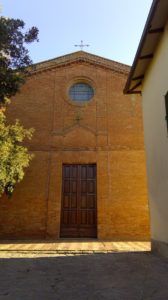La Chiesa era considerata pieve nelle decime della Diocesi di Siena già nel 1276.
Sede di fonte battesimale alla metà del Quattrocento, fu riedificata alla fine del Cinquecento, quando fu realizzata la facciata in mattoni animata da lesene con un rosone centrale e un coronamento ad archetti. Nel transetto si trovano due eleganti altari con la Trinità con angeli, provenienti dalla bottega dei Nasini, e la venerata Madonna delle Grazie di Daniele Lonati (1793).
L’opera di maggior rilievo è la Crocifissione e i Santi Francesco, Marco e Sigismondo (1601) di Francesco Vanni. Il dipinto seicentesco con San Giovanni Battista e la Madonna col Bambino che consegna lo scapolare a San Simone Stock è interessante per la veduta di Cinigiano nello sfondo. Da segnalare l’acquasantiera a fusto (1596), e un mobile da sacrestia dell’inizio del Seicento.
La chiesa si trova in alto rispetto al paese ed è ha accanto un piccolo cimitero caratterizzato dalla presenza di lapidi commemorative per i soldati caduti durante il conflitto mondiale, le lapidi sono sovrastate da alberi di quercia secolari.
The Church was considered parish in the tithes of the Diocese of Siena as early as 1276.
Seat of a baptismal font in the middle of the fifteenth century, it was rebuilt at the end of the sixteenth century, when the brick façade was created, animated by pilasters with a central rose window and a crowning arch. In the transept there are two elegant altars with the Trinity with angels, of Nasiniana workshop, and the venerated Madonna delle Grazie by Daniele Lonati (1793).
The most important work is the Crucifixion and the Saints Francesco, Marco and Sigismondo (1601) by Francesco Vanni. The seventeenth-century painting with St. John the Baptist and the Madonna with Child who delivers the scapular to San Simone Stock is interesting for the view of Cinigiano in the background. Worth mentioning is the stoup (1596), and a sacristy piece from the beginning of the seventeenth century.
The church is located high above the village and is next to a small cemetery characterized by the presence of memorial plaques for soldiers fallen during the world war, the gravestones are dominated by old oak trees.


